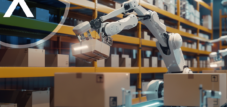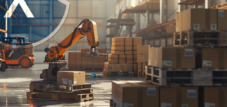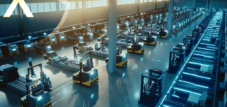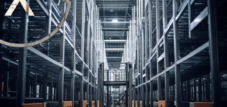Warehouse robotics: increasing efficiency through automation for various warehouse activities such as critical storage, picking and transport
Language selection 📢
Published on: September 26, 2024 / Update from: September 26, 2024 - Author: Konrad Wolfenstein
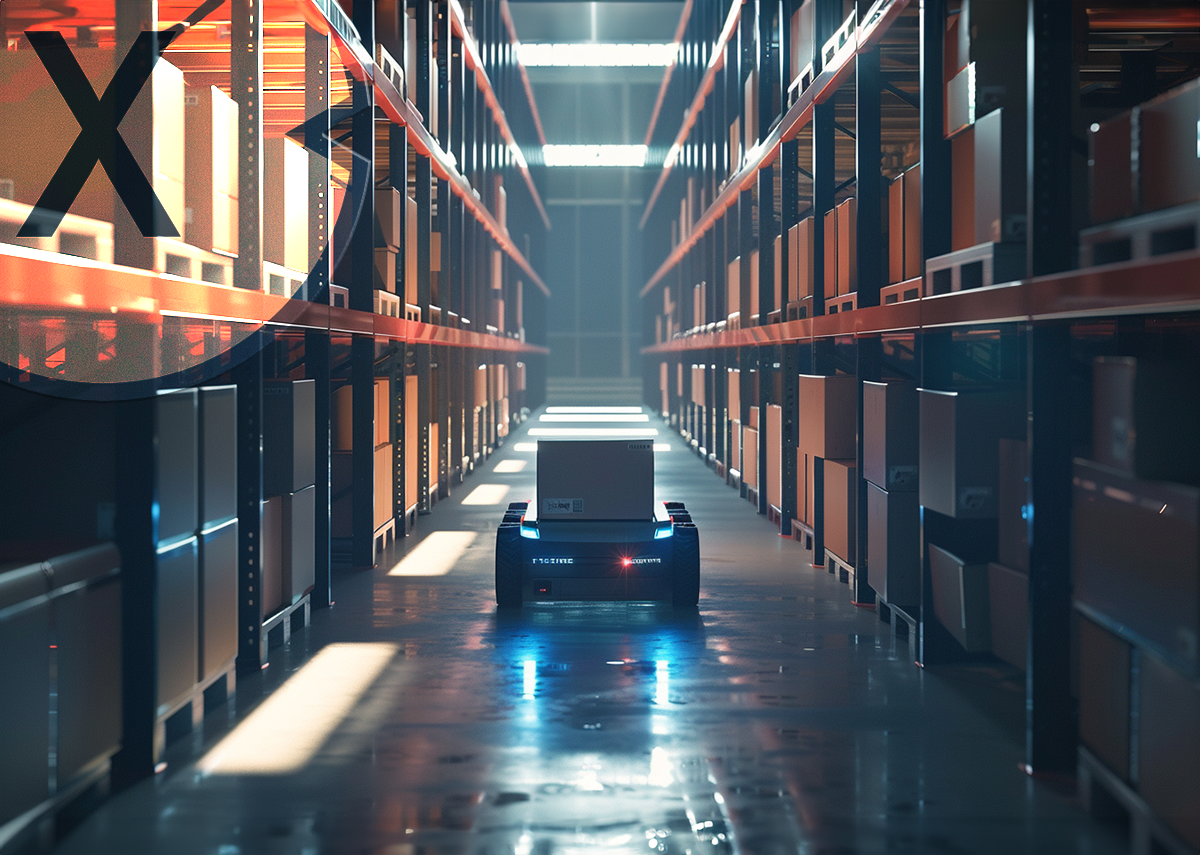
Warehouse robotics: increasing efficiency through automation for various warehouse activities such as critical storage, removal and transport - Image: Xpert.Digital
🤖 Automated warehouses: More efficient, safer and smarter with robotics
📦🤖 The further development of warehouse automation: efficiency gains through advanced robotics
The automation of warehouses has made enormous progress in recent years and is leading to significant efficiency gains. Warehouse robots are increasingly taking over tasks that were previously carried out by humans. They not only increase productivity, but also contribute to employee safety and make optimal use of the available space in the warehouses. The ongoing development of robotics, particularly in combination with artificial intelligence and machine learning, enables these machines to carry out a variety of warehouse activities while remaining flexible and adaptable.
🤖 What is warehouse robotics?
Warehouse robotics refers to the use of machines and automated systems that perform various tasks in warehouses, such as storing, retrieving and transporting goods. These robots use sensors, cameras and often advanced algorithms to perceive their surroundings and react to changes. This allows them to take the fastest and most efficient routes through the warehouse and move safely in complex and dynamic environments.
Robots in warehouses can not only speed up the transport of goods, but also minimize risks for the workforce. For example, they undertake tasks in dangerous areas, such as lifting heavy loads or working in environments that could be harmful to humans. This not only significantly improves productivity, but also occupational safety in the warehouse.
📦 What is critical warehouse robotics?
Critical warehouse logistics refers to the area of warehousing and logistics that deals with the handling, storage and transport of particularly sensitive, valuable or safety-critical goods. These goods require special measures and systems to ensure their integrity, safety and availability. Here are some key features and aspects of critical warehouse logistics:
1. Sensitive and valuable goods
This includes medical products, electronic parts, chemicals, artwork, luxury goods and other high-value or delicate items.
2. Security
Critical warehouse logistics include strict security measures to prevent theft, damage or unauthorized access. This may include the use of surveillance systems, access controls and security guards.
3. Environmental control
Many critical goods require special storage conditions, such as controlled temperature, humidity, air quality and lighting conditions, to maintain their quality and functionality. Examples include food warehouses, pharmaceutical warehouses and warehouses for sensitive electronic components.
4. Traceability and documentation
Complete documentation and traceability are required for many critical products. This can be done through the use of barcodes, RFID technology and advanced warehouse management software (WMS – Warehouse Management System).
5. Risk management
Identification and management of risks that could affect warehouse operations and the goods stored. This includes emergency planning for power outages, natural disasters and other unforeseen events.
6. Regulatory requirements
Compliance with legal and industry regulations that place specific requirements on the storage and transportation of certain goods. This can include the storage of hazardous substances or compliance with health and safety regulations.
These measures ensure that critical goods remain safe, intact and available throughout their storage cycle.
🔍 The main types of warehouse robots
Over time, a variety of specialized warehouse robots have developed, each optimized for specific tasks within a warehouse. The spectrum ranges from simple machines that follow predetermined routes to highly intelligent autonomous robots that find their way independently in complex environments. Here are the main types of warehouse robots used in modern warehouses today:
1. Autonomous Mobile Robots (AMRs)
Autonomous mobile robots, or AMRs for short, are among the most advanced robots in warehouse logistics. They are able to move through a camp independently and without human intervention. Thanks to technologies such as machine learning and artificial intelligence, AMRs plan and optimize their routes in real time. They use a variety of sensors to detect obstacles and flexibly adapt their routes.
A major advantage of AMRs is their ability to overcome unpredictable challenges. For example, they can avoid people or other obstacles and also react to changing warehouse layouts. This flexibility makes AMRs particularly indispensable in dynamic and fast-moving environments. They are ideal for warehouses where the position of shelves or goods is constantly changing, as they are able to take these changes into account in their schedules.
2. Automatically Guided Vehicles (AGVs)
Automatically guided vehicles, known as AGVs, are another important technology in the field of warehouse robotics. These robots follow predefined routes using a combination of sensors, markers and sometimes lasers for navigation. In contrast to the flexible AMRs, AGVs follow rigid paths that are usually predetermined in the warehouse.
AGVs are limited in their ability to adapt to changing environmental conditions. For example, if obstacles unexpectedly appear on their paths, AGVs often cannot respond autonomously. Nevertheless, their reliability and cost-effectiveness make them a widely used solution, especially in less dynamic warehouse environments where layouts rarely change.
3. Automatically Guided Carts (AGCs)
Automatically Guided Carts (AGCs) are very similar to AGVs, but are designed to transport lighter loads. They also follow predefined paths, often marked by magnetic tape or RFID tags in the ground. AGCs are generally smaller and less expensive than their larger siblings, the AGVs.
Because of their lower profile and lower load capacity, AGCs are particularly useful in warehouses where smaller goods need to be transported. They offer an ideal solution for warehouses where fast and precise movements are required without the need to transport heavy loads.
4. Automated Storage and Retrieval Systems (ASRS)
Automated storage and retrieval systems, also known as ASRS, are computer-controlled systems specifically designed for the storage and retrieval of goods. These systems often work on vertical shelves that make optimal use of the available space. An ASRS can automatically pick up goods and bring them to designated transfer points, from where they can then be further processed or transported.
A major advantage of these systems is the enormous increase in efficiency they offer. By using ASRS, storage areas can be better utilized as they are often built higher up, maximizing the available space. In addition, these systems are particularly precise and enable quick access to goods, which is crucial in industries with high throughput requirements.
🌐 The future of warehouse robotics
The future of warehouse robotics will be heavily influenced by advances in artificial intelligence, machine learning and sensor technology. Robots are expected to become increasingly autonomous and able to make complex decisions that previously required human intervention. For example, future robots could be able to manage the entire inventory and decide when which goods need to be moved, stored or delivered based on real-time data.
Another important trend in warehouse robotics is the increasing integration of robots with other automated systems. In a fully automated warehouse of the future, different types of robots, from AMRs to AGVs to ASRS, could work together seamlessly to achieve the highest possible efficiency. These systems could communicate with each other in real time to avoid bottlenecks and optimize workflow.
🚀 The advantages of warehouse robotics
Implementing warehouse robotics offers numerous benefits, both in terms of efficiency and safety. One of the biggest benefits is the reduction in labor costs. Robots can work around the clock and do not require breaks, significantly increasing productivity. They can also take on tasks that are monotonous or physically demanding for people, which increases employee job satisfaction.
Another important advantage is the improvement in workplace safety. Robots can work in dangerous environments such as: B. in areas with heavy machinery or when handling hazardous materials. This minimizes risks to the human workforce. In addition, robots can work precisely and without fatigue, reducing the risk of errors and therefore increasing quality and accuracy in warehouse operations.
📊 Efficient solutions for different requirements
Robotics is revolutionizing the way warehouses are operated. The different types of warehouse robots, such as AMRs, AGVs, AGCs and ASRS, offer flexible and efficient solutions for different requirements. The integration of these technologies leads to a dramatic increase in efficiency and productivity while improving employee safety and satisfaction. In the coming years, robotics will continue to play a central role in warehouse logistics and has the potential to sustainably change the entire industry. Investing in warehouse robotics is therefore not just a question of efficiency, but also an important step into the future of logistics.
📣 Similar topics
- 🤖 Automation in warehouses
- 📦 Advances in warehouse logistics
- 🚀 Efficiency through warehouse robotics
- 🤖 Security and productivity
- 📉 Reducing labor costs through robotics
- 📊 Critical warehouse logistics
- 🔧 Warehouse robot technology
- 🌐 Future of warehouse automation
- ⚙️ Autonomous Mobile Robots (AMRs)
- 🛠️ Advantages of robotics in the warehouse
#️⃣ Hashtags: #warehouse automation #warehouse robotics #increasing efficiency #artificialintelligence #occupational safety
Xpert partner in warehouse planning and construction
We are there for you - advice - planning - implementation - project management
☑️ Smart City & Factory: Industry expert for energetic 5G buildings and halls as well as advice and installation of solar systems
☑️ Xpert.Plus - logistics consulting and logistics optimization
☑️ Industry expert, here with his own Xpert.Digital Industry Hub with over 2,500 specialist articles
I would be happy to serve as your personal advisor.
You can contact me by filling out the contact form below or simply call me on +49 89 89 674 804 (Munich) .
I'm looking forward to our joint project.
Xpert.Digital - Konrad Wolfenstein
Xpert.Digital is a hub for industry with a focus on digitalization, mechanical engineering, logistics/intralogistics and photovoltaics.
With our 360° business development solution, we support well-known companies from new business to after sales.
Market intelligence, smarketing, marketing automation, content development, PR, mail campaigns, personalized social media and lead nurturing are part of our digital tools.
You can find out more at: www.xpert.digital - www.xpert.solar - www.xpert.plus







